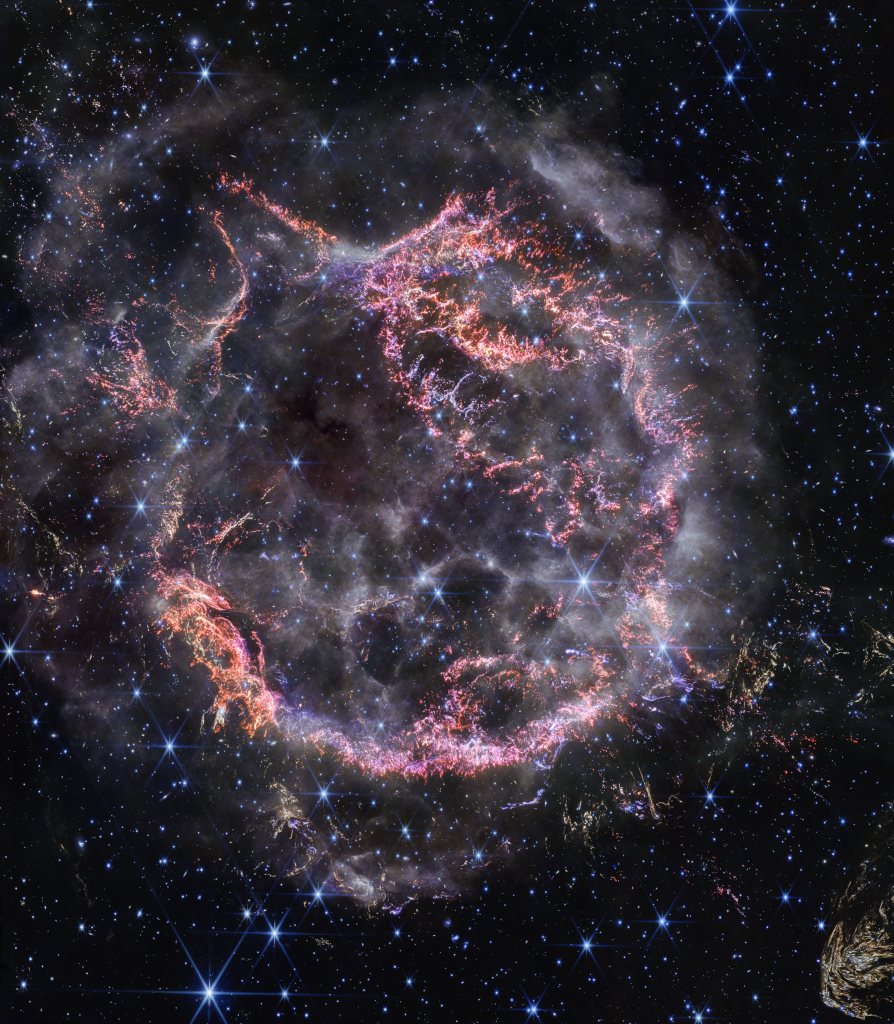2023年12月14日
Supernova Remnant Cassiopeia A
Image Credit: NASA, ESA, CSA, STScI; D. Milisavljevic (Purdue University), T. Temim (Princeton University), I. De Looze (University of Gent)
Explanation: Massive stars in our Milky Way Galaxy live spectacular lives. Collapsing from vast cosmic clouds, their nuclear furnaces ignite and create heavy elements in their cores. After only a few million years for the most massive stars, the enriched material is blasted back into interstellar space where star formation can begin anew. The expanding debris cloud known as Cassiopeia A is an example of this final phase of the stellar life cycle. Light from the supernova explosion that created this remnant would have been first seen in planet Earth’s sky about 350 years ago, although it took that light 11,000 years to reach us. This sharp NIRCam image from the James Webb Space Telescope shows the still hot filaments and knots in the supernova remnant. The whitish, smoke-like outer shell of the expanding blast wave is about 20 light-years across, while the bright speck near center is a neutron star, the incredibly dense, collapsed remains of the massive stellar core. Light echoes from the massive star’s cataclysmic explosion are also identified in Webb’s detailed image of supernova remnant Cassiopeia A.
Tonight watch: The Geminids
Tomorrow’s picture: stellar eclipse
超新星遗迹仙后A
影像提供: NASA, ESA, CSA, STScI; D. Milisavljevic (Purdue University), T. Temim (Princeton University), I. De Looze (University of Gent)
说明: 我们银河系里的大质量恒星过着绚烂无比的日子。它们从庞大的宇宙云塌缩诞生,当核子火炉点燃之后,就不停的在核心合成重元素。大部分的大质量恒星经过短短的数百万年之后,就会发生爆炸,把恒星内部经过浓化的物质喷回星际空间,成为制作下一世代恒星的材料。上面影像中这团名为仙后A(Cas A)的碎片云,就是恒星生命循环最后阶段的例证之一。大约在350年前,人类首次在地球天空中见到产生此遗迹的超新星爆炸所发出的光,不过这些光需时11,000年才能传达地球。这幅韦伯太空望远镜的清晰近红外相机影像,呈现了这个超新星遗迹里依然炽热的云气丝及物质结。其中,扩张震波所产生的泛白烟雾状外壳,直径约有20光年,其中心附近的明亮光斑则是中子星,为大质量恒星核塌缩后,所留下的无比致密残骸。在韦伯望远镜为仙后A超新星遗迹拍摄的细致影像里,还可办认出源自大质量恒星剧烈爆炸的回光。
今晚观看: 双子座流星雨
明日的图片: stellar eclipse



